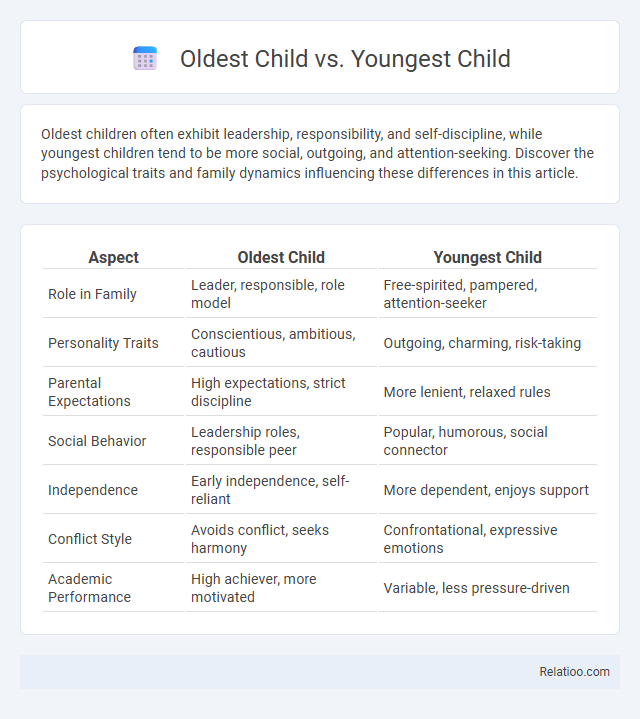Oldest children often exhibit leadership, responsibility, and self-discipline, while youngest children tend to be more social, outgoing, and attention-seeking. Discover the psychological traits and family dynamics influencing these differences in this article.
Table of Comparison
| Aspect | Oldest Child | Youngest Child |
|---|---|---|
| Role in Family | Leader, responsible, role model | Free-spirited, pampered, attention-seeker |
| Personality Traits | Conscientious, ambitious, cautious | Outgoing, charming, risk-taking |
| Parental Expectations | High expectations, strict discipline | More lenient, relaxed rules |
| Social Behavior | Leadership roles, responsible peer | Popular, humorous, social connector |
| Independence | Early independence, self-reliant | More dependent, enjoys support |
| Conflict Style | Avoids conflict, seeks harmony | Confrontational, expressive emotions |
| Academic Performance | High achiever, more motivated | Variable, less pressure-driven |
Birth Order Overview: Oldest vs Youngest
Oldest children often assume leadership roles and exhibit higher responsibility due to early family expectations and hierarchical positioning. Youngest children tend to receive more leniency and foster creativity and social skills as the family dynamics shift with each new addition. Birth order influences personality traits, social behavior, and sibling relationships within the family hierarchy, shaping individual development uniquely for oldest versus youngest siblings.
Personality Traits of the Oldest Child
Oldest children often exhibit leadership qualities, responsibility, and a strong sense of duty due to their position in the hierarchical family structure. Your role as the eldest typically fosters traits such as reliability, ambition, and a need for approval, shaped by expectations to set examples for younger siblings. Understanding these personality traits helps explain how birth order influences behavior within family dynamics.
Personality Traits of the Youngest Child
Youngest children often exhibit traits such as creativity, sociability, and a strong desire for attention due to their position in the hierarchical structure of the family. They tend to be more rebellious and risk-taking compared to oldest children, who are typically responsible and achievement-oriented. Understanding how birth order influences your personality can provide deeper insight into family dynamics and individual behavior.
Family Dynamics and Sibling Roles
Oldest children often assume leadership and responsibility roles within the family hierarchy, shaping sibling dynamics through expectations of maturity and caretaking. Youngest children typically navigate more lenient boundaries, benefiting from increased attention but facing challenges in asserting independence. Hierarchical family structures influence communication patterns, authority distribution, and conflict resolution, impacting the development of sibling roles and individual identities.
Academic Achievement and Birth Order
Research in academic achievement consistently shows that oldest children tend to outperform their younger siblings due to increased parental attention and higher expectations during critical developmental periods. Youngest children often benefit from more relaxed parental environments but may receive less academic investment, impacting their scholastic outcomes. Hierarchical family structures influence resource allocation and sibling roles, creating dynamics where birth order significantly affects cognitive development and educational success.
Leadership and Responsibility: Oldest Children
Oldest children often assume leadership roles within family hierarchies due to early responsibilities such as caregiving and decision-making, fostering strong organizational and authority skills. Their position typically cultivates a sense of duty and reliability, which translates into effective leadership qualities in professional and social settings. This dynamic stems from hierarchical structures that place the oldest child in a quasi-parental role, shaping their approach to responsibility and influence.
Creativity and Attention: Youngest Children
Youngest children often exhibit heightened creativity due to less rigid family expectations and greater exposure to diverse influences within the hierarchical structure. Their position encourages risk-taking in creative pursuits as they receive more attention tailored to their unique needs and developmental stages. You can harness this natural advantage by providing supportive environments that nurture their inventive potential and individual expression.
Parental Expectations and Treatment
Oldest children often face high parental expectations to be responsible and set examples, while youngest children may receive more leniency and attention due to their position in the family hierarchy. Middle children frequently experience distinct treatment, sometimes feeling overlooked, which shapes their roles and behaviors within family dynamics. Understanding these differences helps you navigate the varied parental expectations and treatment based on birth order.
Social Skills and Peer Relationships
Oldest children often develop strong leadership skills and responsibility within hierarchical family structures, influencing their social competence and peer relationships through early caretaking roles. Youngest children typically exhibit higher levels of social playfulness and attention-seeking behavior, which can enhance their ability to form peer connections but may also lead to challenges in authority dynamics. Hierarchical family roles shape sibling interactions, where middle children navigate complex social positioning, balancing assertiveness and cooperation in peer engagements.
Myths and Facts About Birth Order Effects
Birth order effects often lead to myths that the oldest child is always a natural leader, the youngest is perpetually spoiled, and middle children are neglected, yet research shows personality traits vary widely within families. Studies indicate that hierarchical structure within families influences behavior less than individual parent-child relationships and external factors like socio-economic status and education. Understanding these nuances helps you avoid stereotyping siblings based solely on birth order, emphasizing that personal development is shaped by many complex elements beyond family position.

Infographic: Oldest Child vs Youngest Child
 relatioo.com
relatioo.com